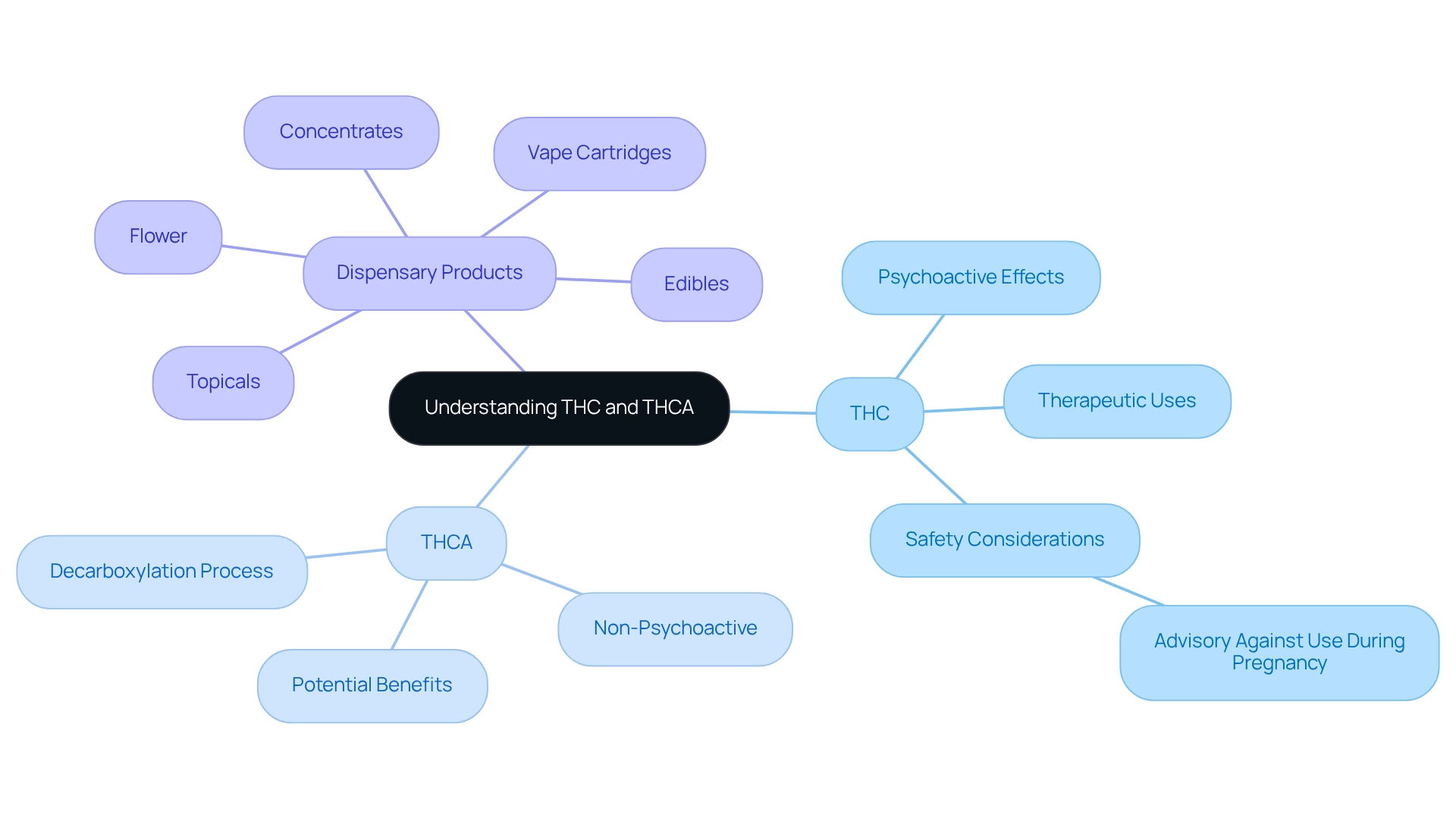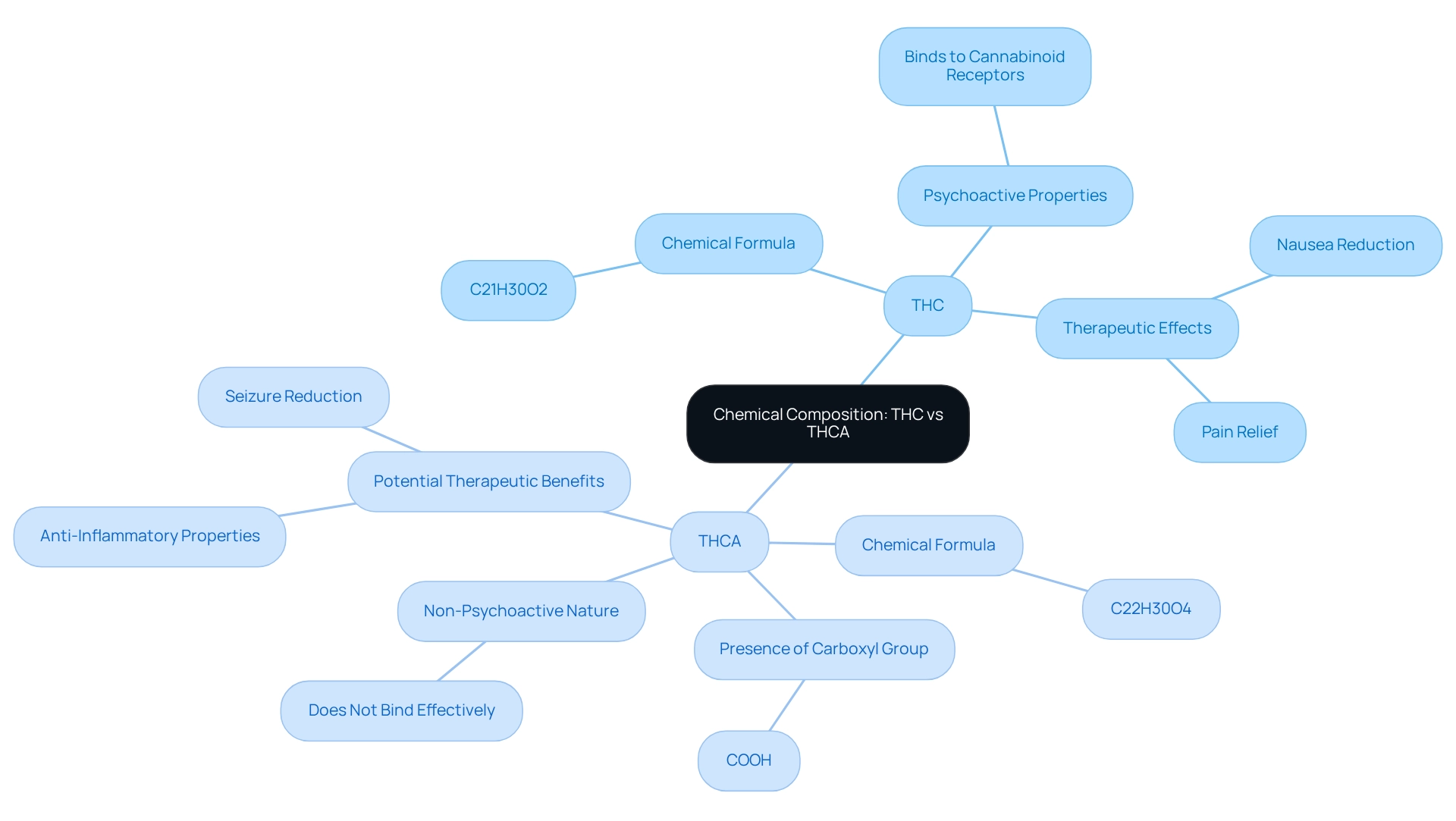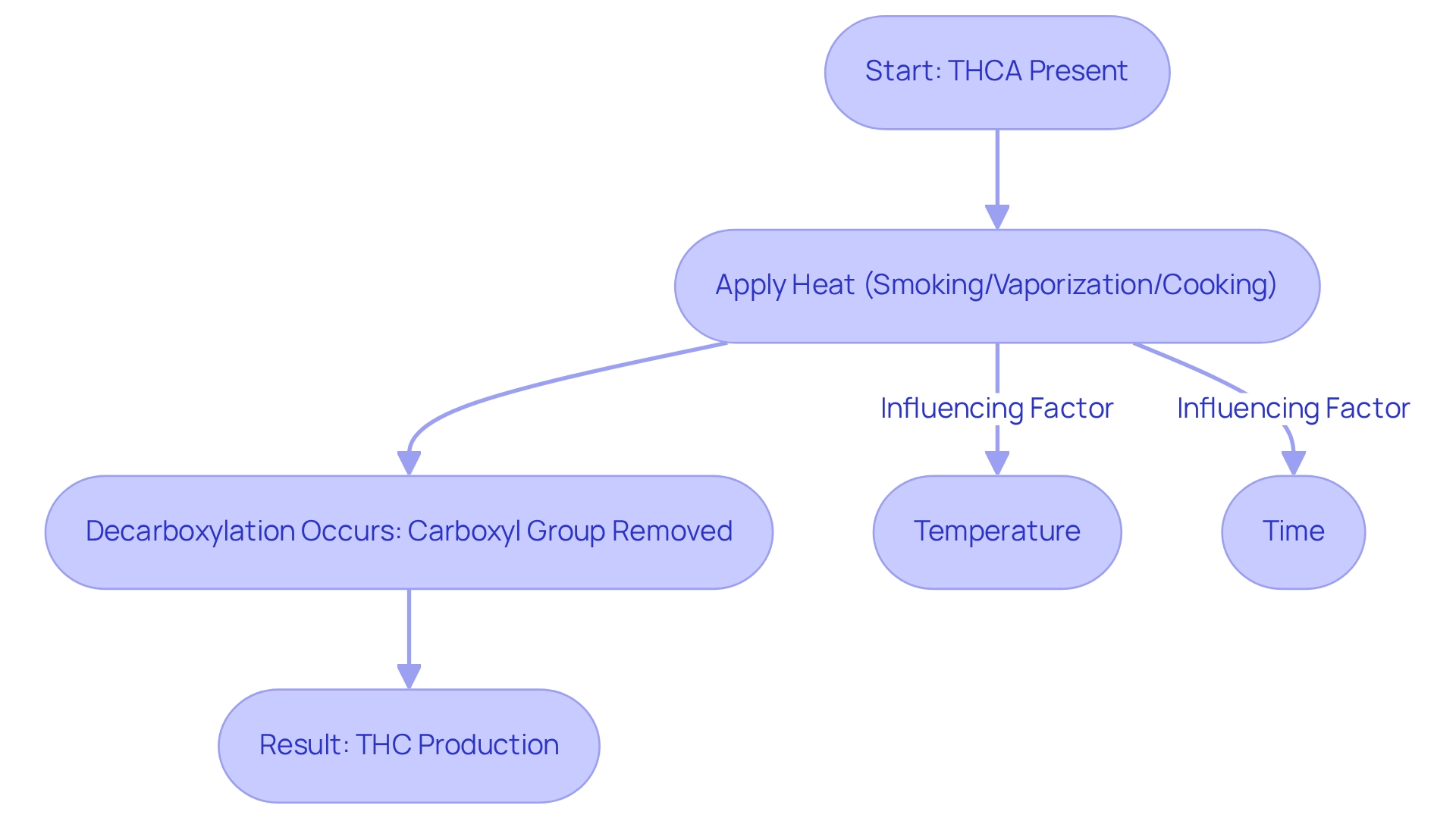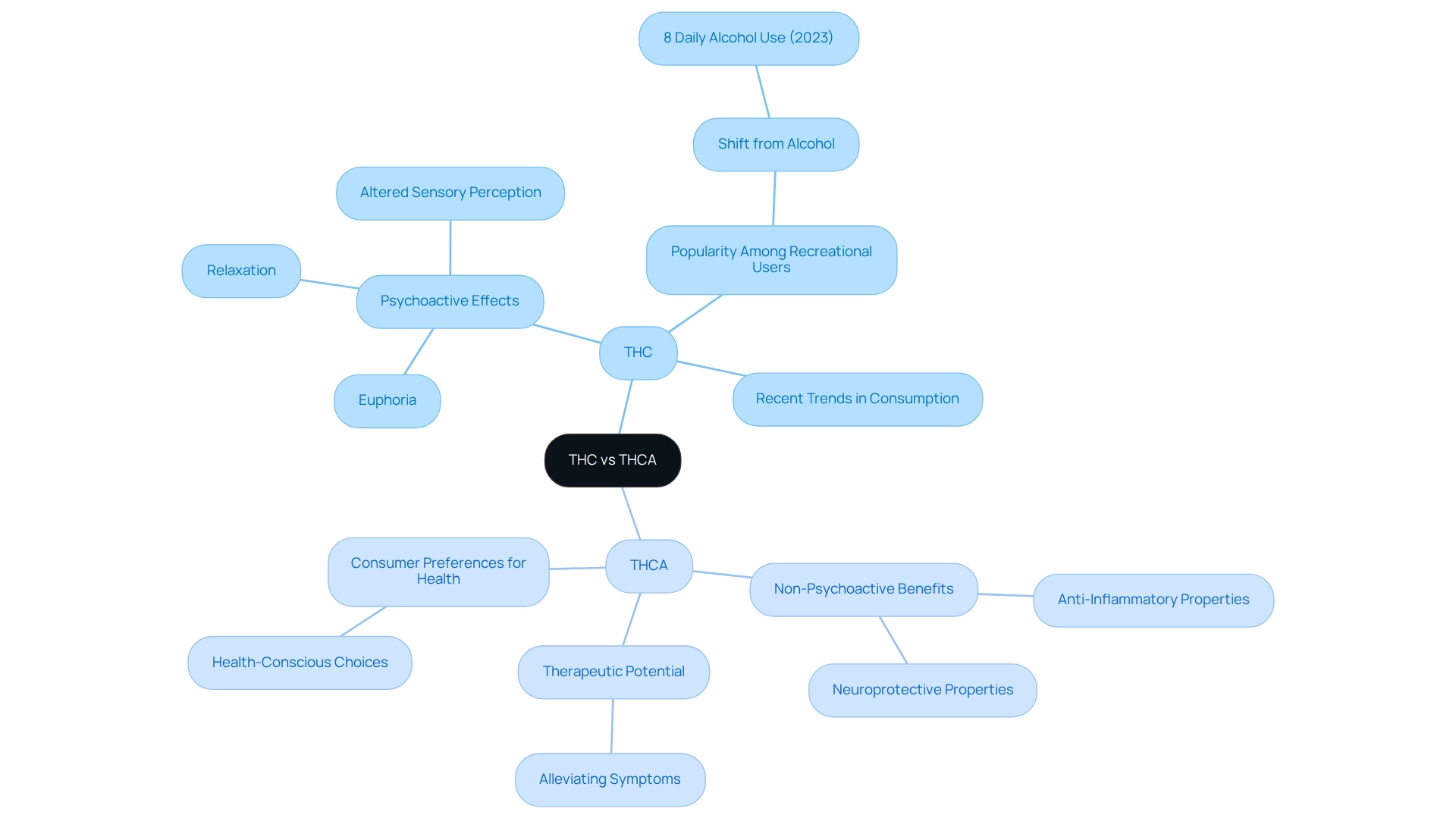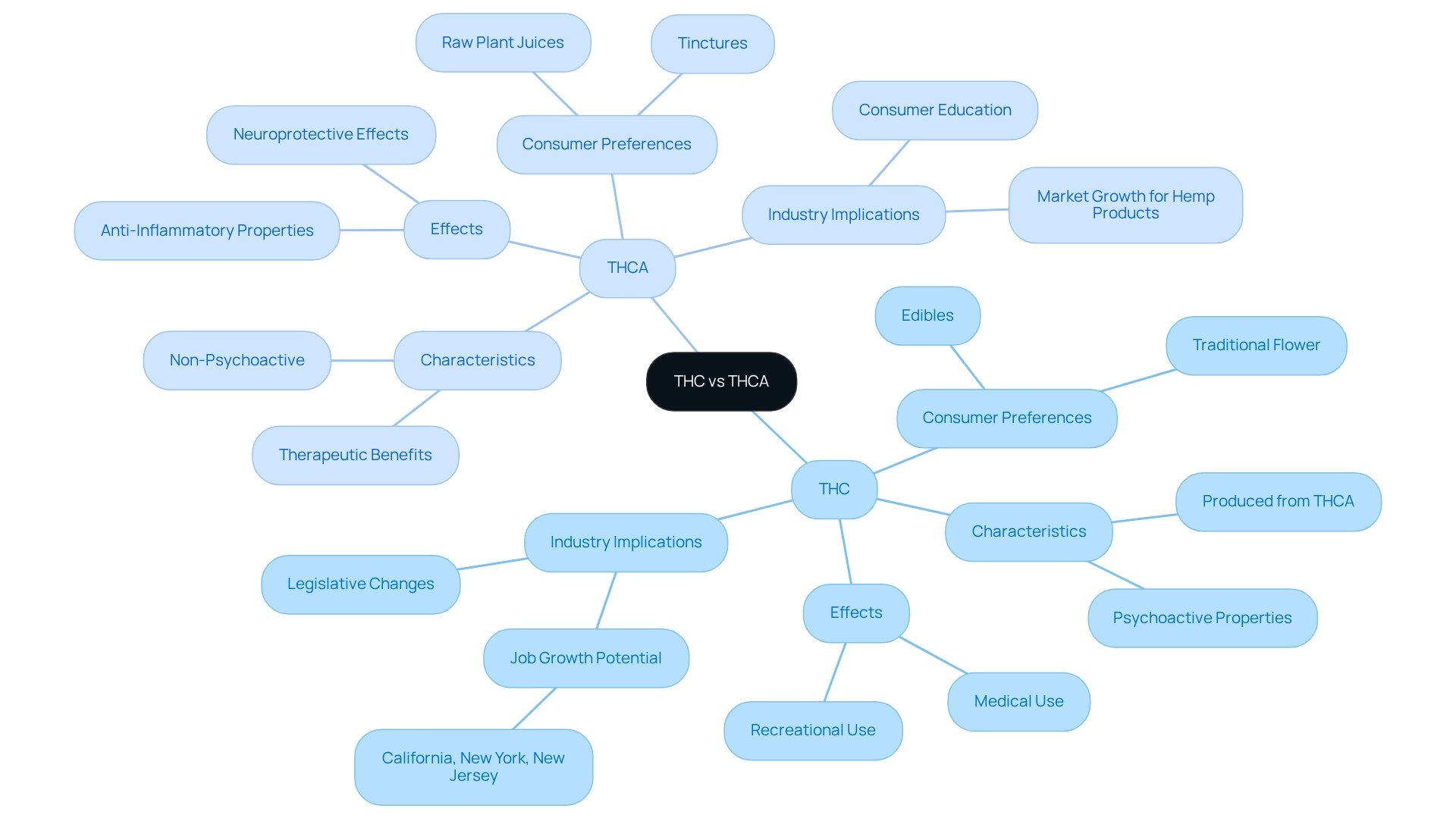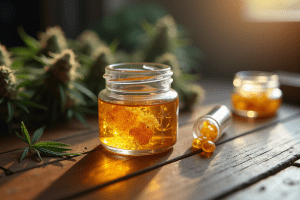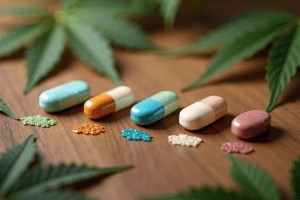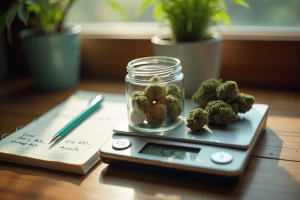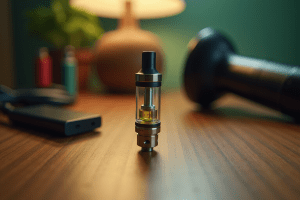Overview
This article thoughtfully compares THC and THCA, helping us understand their differences. THC is the psychoactive compound that brings about the euphoric effects of marijuana, while THCA serves as a non-psychoactive precursor that may offer potential therapeutic benefits. By examining their chemical structures and how they affect our bodies, the article sheds light on important implications for our choices in both medical and recreational contexts.
Have you ever wondered how these compounds might influence your experience? Understanding these distinctions can empower you to make informed decisions that align with your needs and preferences. Together, we can explore the fascinating world of cannabis and its potential benefits.
As you consider your options, remember that knowledge is key. This article provides valuable insights that can guide you on your journey towards better health and well-being. Let’s delve deeper into these topics and discover how they can enrich our lives.
Introduction
In the ever-evolving landscape of cannabis, understanding the distinction between THC and THCA is essential for both recreational and medicinal users. Have you ever wondered how these compounds affect your experience? While THC is celebrated for its psychoactive effects, delivering the euphoric high that many seek, THCA remains largely underappreciated despite its potential therapeutic benefits. As more consumers explore the diverse applications of cannabis, knowledge about these two compounds becomes crucial for making informed choices that align with your health goals and personal preferences.
With increasing research shedding light on their unique properties, we can together navigate this complex world of cannabis. This article delves into the intricacies of THC and THCA, exploring their chemical compositions, conversion processes, and the implications for consumption methods. By understanding these elements, you can feel empowered to make decisions that enhance your well-being and enjoyment.
Understanding THC and THCA: Definitions and Basics
Tetrahydrocannabinol (THC) is widely recognized as the main psychoactive substance in marijuana, responsible for the euphoric ‘high’ that many users experience. In contrast, tetrahydrocannabinolic acid serves as the non-psychoactive precursor to THC, found in unprocessed marijuana plants. This compound remains inactive until it undergoes decarboxylation, a chemical reaction that occurs when the plant is heated, such as during smoking or cooking.
Understanding this change is essential, especially for those exploring the therapeutic and recreational uses of these substances. As marijuana continues to be the most frequently utilized federally prohibited drug in the United States, grasping its elements—particularly the differences between THC and THCA—is becoming increasingly significant. Recent studies have highlighted the importance of educating consumers about these distinctions. For instance, the National Institute on Drug Abuse (NIDA) has financed extensive research into marijuana, focusing on its health effects and potential therapeutic applications.
Ongoing studies, such as the HEALthy Brain and Child Development Study, aim to provide insights into how marijuana exposure affects individuals at various life stages. This further emphasizes the need for informed decision-making. Navigating marijuana dispensaries is a vital part of this education. Dispensaries, like Leafy Mate, offer a variety of marijuana products, including:
- flower (buds)
- edibles (e.g., gummies, chocolates)
- concentrates (e.g., shatter, wax)
- vape cartridges
- topicals (e.g., creams, balms)
Understanding the types of dispensaries—medical and recreational—and the products they provide can empower us to make informed choices.
Budtenders at these dispensaries are knowledgeable professionals who can assist you in selecting the right products for your needs. Their expertise underscores the importance of effective communication among healthcare professionals, which can enhance patient outcomes for those using THC formulations. Safety is also a critical consideration, particularly for vulnerable populations. The American College of Obstetricians and Gynecologists advises against marijuana use during pregnancy and breastfeeding, highlighting the importance of responsible use.
By familiarizing ourselves with local marijuana laws and regulations, we can ensure compliance and safety in our usage. Understanding the nuances of THC vs. THCA is essential for anyone navigating the marijuana landscape, especially as the industry continues to evolve. By grasping these fundamental concepts, we can better appreciate the diverse effects and benefits associated with different cannabis products, ensuring a positive and informed experience together.
Chemical Composition: THC vs THCA
The chemical structures of THC and THCA are distinct, primarily due to the presence of a carboxyl group (COOH) in THCA. THC is defined by the chemical formula C21H30O2, while tetrahydrocannabinolic acid features a more intricate formula of C22H30O4, indicating that extra carboxyl group. This structural difference is crucial, as it renders THCA non-psychoactive; it cannot effectively bind to cannabinoid receptors in the brain like THC does.
Understanding this fundamental distinction between THC and THCA is essential for grasping the varying effects and therapeutic roles of these compounds in cannabis consumption. Have you ever considered how these differences might affect your choices in using cannabis?
Recent studies have highlighted the implications of this structural difference. For instance, research has shown that the carboxyl group in tetrahydrocannabinolic acid influences its solubility and stability, which can affect how it is metabolized in the body. Furthermore, the chemical composition of both compounds has been extensively analyzed, revealing that THC is often sought for its psychoactive effects, while THCA offers potential therapeutic benefits without the high.
Significantly, a study gathered 200 mg of dried medicinal herb or 0.2 mL of oil derived from the plant from each participant, providing a foundation for understanding the effects of these compounds in practical applications. This evidence can empower patients to make informed decisions about their treatment options.
The medical advantages of marijuana are extensive, particularly in addressing conditions like epilepsy, chronic pain, and nausea linked to chemotherapy. For example, medical cannabis has been shown to reduce seizures in children with severe epilepsy by up to 50%, offering hope to families seeking effective treatment options. This holistic approach allows patients to explore alternatives to traditional medications, which often come with harmful side effects.
Expert insights into the chemical composition of THC and THCA underscore the importance of these differences. Chemists have noted that the unique structure of THCA may contribute to its anti-inflammatory properties, making it a valuable compound for medical applications. Remo Monti, a Statistical Data Evaluator, highlighted the significance of these findings, stating, “Understanding the chemical structures of cannabinoids is crucial for advancing marijuana research and product development.”
Furthermore, case studies comparing targeted and untargeted analytical methods in marijuana research have shown that comprehending these chemical structures is essential for product standardization and enhancing bioanalytical data interpretation. This approach provides a versatile means for cannabinoid fingerprinting at the product level, which is key for ensuring product quality and safety.
In summary, the differences in chemical structure observed in THC and THCA not only define their psychoactive properties but also influence their therapeutic potential, making them significant in both recreational and medical contexts. Moreover, the identification of compounds like Quercetin, Naringenin, and Naringin in the hydroalcoholic extract of hemp inflorescence underscores the chemical diversity found in the plant, further enhancing the discussion on its therapeutic applications. By recognizing the potential side effects of traditional medications, we can make informed choices about using medical marijuana as a safer alternative, together exploring the benefits it may offer.
The Conversion Process: How THCA Becomes THC
The transformation of cannabinoids to THC is an essential process known as decarboxylation. This occurs when heat is applied to the plant, whether through smoking, vaporization, or cooking. During these methods, heat effectively removes the carboxyl group from THCA, resulting in the psychoactive compound THC. For those seeking the euphoric effects associated with marijuana, this conversion is particularly significant, as THC is the compound responsible for the ‘high.’
Research shows that the efficiency of this conversion can vary, with studies indicating that only about 30% of THC is recovered during smoking. It’s also important to note that the concentration of THC varies within the plant; upper flowers contain approximately 12% THC, while lower flowers have about 6%. Understanding the decarboxylation process is crucial for optimal consumption.
Temperature and time are vital factors that influence the efficacy and quality of the final product. Being aware of these variables is essential when preparing marijuana for use. For new users, considering the types of dispensaries available can be beneficial. Medical dispensaries cater to patients with valid medical marijuana cards, offering products tailored for specific conditions. In contrast, recreational dispensaries serve adults aged 21 and over, providing a variety of marijuana products, including flower, edibles, and concentrates.
Understanding the different strains can enhance the consumption experience. Indica is known for relaxation, Sativa for energy, and hybrids offer a balance between the two. This knowledge empowers users to make choices that suit their needs.
Expert opinions highlight the distinct pharmacological differences between THC and THCA. As researcher Crist N. Filter notes, ‘The pharmacology of acidic and neutral cannabinoids has been found to be very different, particularly in the case of THC vs THCA.’ This conversion process is not merely a chemical reaction; it plays a crucial role in marijuana consumption, impacting both recreational and medicinal uses.
Recent studies have delved into the nuances of this conversion, providing valuable insights that can help users maximize the benefits of marijuana. Additionally, the case study titled “Analytical Standards for Cannabinoid Research” emphasizes the importance of accurate cannabinoid quantification, essential for understanding the decarboxylation process. Many marijuana users are becoming increasingly informed about THC conversion and its implications for their experiences.
By grasping the decarboxylation process and the variety of products available at dispensaries, we can make informed decisions that enhance our enjoyment and therapeutic outcomes in the evolving landscape of marijuana use. Together, let’s explore these options to ensure a fulfilling experience.
Psychoactive Effects: THC’s High vs THCA’s Benefits
THC is widely recognized for its psychoactive effects, often experienced as euphoria, relaxation, and altered sensory perception. These characteristics make THC a popular choice among recreational users seeking an elevated experience. In 2023, a noteworthy trend emerged: 8% of adults aged 35 to 50 reported daily alcohol consumption, signaling a shift towards alternative substances like marijuana for relaxation and enjoyment.
Conversely, the non-psychoactive precursor to THC does not produce intoxicating effects in its unprocessed state. Yet, emerging research highlights its potential therapeutic benefits, including anti-inflammatory and neuroprotective properties. This positions this compound as an appealing option for those seeking the health advantages of marijuana without the high typically associated with THC.
Recent findings suggest that THCA may play a role in alleviating symptoms of various conditions, making it a valuable consideration for health-conscious consumers. Have you ever wondered about the differences between THC and THCA? Understanding these distinctions can empower you to make informed choices that align with your health needs.
At Leafy Mate, we are dedicated to building trust within the industry by connecting our customers to high-quality, trusted brands and medical marijuana doctors across North America. We recognize the importance of informing consumers to select the right brands for a safe and enjoyable experience. Our collaborations with leaders in the retail marijuana sector enhance our credibility and the quality of the products we recommend.
Expert insights emphasize understanding the differences between THC and THCA. Health professionals observe that while THC can deliver instant psychoactive effects, its non-psychoactive form offers a gentler approach to wellness, appealing to individuals who wish to avoid intoxication. Real-world examples demonstrate an increasing consumer preference for THCA among those prioritizing health benefits over recreational use.
Furthermore, the Australian National Council on Drugs cautions that marijuana and other cannabinoids are not recommended during pregnancy, highlighting the importance of safety for consumers. Case studies from the National Institute on Drug Abuse (NIDA) underscore the need for ongoing research into the health effects of marijuana. NIDA’s initiatives aim to deepen our understanding of marijuana use and its implications for public health, especially among vulnerable populations.
It is crucial to note that NIDA does not provide personalized medical advice, treatment, counseling, or legal consultation, which is vital for consumers navigating marijuana use.
As the marijuana landscape evolves, the distinction between THC and THCA becomes increasingly relevant, guiding consumers in making informed choices that reflect their health and lifestyle preferences. While the health consequences of marijuana use in developing nations remain largely unknown, biological effects are expected to mirror those observed in developed countries, further emphasizing the need for informed decision-making. At Leafy Mate, we also offer product deals and savings opportunities, ensuring our customers receive the best value while exploring their options.
Therapeutic Benefits: Medical Uses of THC and THCA
THC is widely recognized in medical contexts for its ability to alleviate pain, reduce nausea, and stimulate appetite. This is especially beneficial for patients undergoing chemotherapy or those suffering from chronic pain conditions. Did you know that recent studies show approximately 70% of young adults report using marijuana for medical purposes? This highlights its importance in contemporary healthcare. Logistic regression analyses indicate that cannabis use for medical purposes is significantly linked to cannabis policy conditions, age, and gender, emphasizing the need to understand the broader context of cannabis use.
On the other hand, a certain compound has emerged as a promising option in preliminary research, showcasing anti-inflammatory, anti-nausea, and neuroprotective properties. These attributes position this compound as a potential treatment for conditions like arthritis, inflammatory bowel disease, and neurodegenerative disorders. Understanding the unique therapeutic advantages of THC versus THCA is crucial, as expert opinions suggest.
Medical professionals are advocating for further research to explore the full potential of these compounds. It is essential that patients have access to comprehensive information to make informed decisions about their treatment options. For instance, a recent case study titled ‘Challenges in Understanding Medical Cannabis Use’ revealed that patients using THCA reported significant symptom improvements without the psychoactive effects associated with THC. This suggests a valuable alternative for those seeking relief without intoxication.
Moreover, the latest research indicates that the therapeutic benefits of THC extend beyond symptom management. Studies show its efficacy in enhancing the quality of life for patients with various medical conditions. As Charles W. Webb, MD, powerfully stated, ‘Patients deserve to have marijuana released from its current federal prohibition so that scientific research can proceed and so that physicians can prescribe it with the same freedom accorded any other safe and effective medications.’
At Leafy Mate, we are dedicated to building trust in the marijuana sector through transparency and education. Our goal is to ensure that new users are well-informed about their options. We actively provide educational resources, including workshops and informational guides, to help consumers navigate their choices. As California’s marijuana regulations continue to evolve, understanding the nuances of THC versus THCA will empower patients to choose the most suitable treatment options tailored to their specific needs.
For example, recent changes in legislation have expanded access to medical cannabis, allowing more patients to benefit from these treatments. Together, we can explore these options and find the right path for your health and well-being.
Legal Considerations: THC and THCA in the Cannabis Landscape
The legal status of THC presents a complex landscape that varies widely across jurisdictions. Often classified as a controlled substance, THC is subject to stringent regulations in many areas, which can complicate its use for consumers. However, it is generally regarded as legal under federal law, especially when obtained from hemp and containing less than 0.3% THC, as defined by the 2018 Agriculture Improvement Act.
This important legislation has significantly influenced the marijuana market, leading to a surge in legal marijuana products available at dispensaries.
Navigating this legal framework is essential. Individual states impose their own restrictions regarding THC vs. THCA. For instance, Oklahoma stands out with the highest number of marijuana dispensaries per capita, boasting 36 dispensaries for every 100,000 residents. This reflects a more permissive approach to marijuana regulation. Could this trend in Oklahoma suggest a shift towards wider acceptance of marijuana? According to the Pew Research Center, 74% of Americans now reside in a state where it is legal for either recreational or medical purposes.
In contrast, other states may have more restrictive laws, creating a patchwork of regulations that individuals must navigate.
Understanding the types of dispensaries—medical and recreational—is crucial for new marijuana users. Medical dispensaries cater to patients with valid medical marijuana cards, offering products tailored for specific medical conditions. On the other hand, recreational dispensaries serve adults aged 21 and over without requiring a medical card. Both categories provide a range of marijuana products, including flower, edibles, concentrates, and more.
Real-world instances demonstrate the difficulties encountered by buyers. Many individuals have reported confusion regarding the legality of various cannabis products, particularly when transitioning from states with differing laws. Legal experts emphasize the importance of staying informed about local regulations to avoid potential legal issues.
As discussions persist regarding the necessity for a more consistent federal strategy for regulating intoxicating hemp-derived products, highlighted by the case study on ‘Federal Uniformity in Hemp Regulation,’ we urge individuals to stay alert and informed about the changing legal framework concerning THC vs. THCA. Always remember to consume responsibly and consult with knowledgeable budtenders at dispensaries to make informed decisions. Together, we can navigate this evolving landscape with confidence.
Consumption Methods: How to Use THC and THCA
THC can be consumed through a variety of methods, each offering unique experiences and effects tailored to individual preferences. Common consumption methods include smoking, vaping, edibles, and tinctures. For those seeking quick relief, smoking or vaping delivers immediate effects, making them popular choices.
The sensory experience of smoking—whether through the fiery dance of a joint, the smooth embrace of a glass pipe, or the discreet pleasure of a one-hitter—adds a ritualistic element that many users cherish. In contrast, edibles, while taking longer to produce effects, often provide prolonged relief, appealing to those looking for sustained benefits. It’s important to note that approved marijuana products are only available with a prescription from a licensed healthcare provider, which new users should be aware of.
Did you know that THCA, the non-psychoactive precursor to THC, can be consumed in its raw form, such as in smoothies or salads? This allows individuals to enjoy its therapeutic benefits without the psychoactive effects. This method is gaining traction among health-conscious consumers who prefer to incorporate hemp into their diets without the high. Furthermore, THCA can be converted to THC through cooking or heating, adding versatility for those seeking both therapeutic and psychoactive effects. Understanding THC vs. THCA is essential as recent trends indicate a growing interest in various consumption methods, with many users experimenting to find their preferred way.
Expert opinions suggest that the choice of consumption method can significantly influence the overall experience. Some health experts advocate for edibles due to their longer-lasting effects, while others recommend smoking or vaping for immediate relief. Real-world examples illustrate diverse preferences; some may opt for the convenience of tinctures for precise dosing, while others enjoy the ritual of rolling a joint. As the marijuana market continues to evolve, understanding these consumption methods and their effects is crucial for informed decision-making.
Projections estimate that total revenue from marijuana will reach $45.3 billion by 2025, underscoring the growing interest in consumption methods. A Pew Research Center study discovered that 54% of Americans reside in a state where the recreational use of marijuana is permitted, emphasizing the growing acceptance and availability of the substance. However, limitations in studies, such as reliance on self-reported data, may affect the reliability of user experiences and preferences regarding consumption methods.
Moreover, monitoring systems like the State Cannabis Policy Enactment Database provide up-to-date information on marijuana legislation, aiding stakeholders in understanding the legal landscape surrounding its use and its implications. As the marijuana sector keeps expanding, the need for information regarding THC vs. THCA and their consumption methods is more pertinent than ever. Together, let’s explore these options and make informed choices that suit our individual needs.
Key Takeaways: THC vs THCA – A Summary
THC and another cannabinoid represent two distinct compounds, each with unique characteristics and effects that cater to various user needs. THC, or tetrahydrocannabinol, is widely recognized for its psychoactive properties, making it a popular choice for both recreational and medical use. On the other hand, tetrahydrocannabinolic acid is non-psychoactive and is gaining attention for its potential therapeutic benefits, allowing users to enjoy the health advantages of the plant without the intoxicating effects associated with THC.
Understanding the chemical differences between THC and THCA is essential for consumers. THC is produced through the decarboxylation of THCA, a process that occurs when marijuana is heated, such as during smoking or cooking. This conversion not only activates THC but also alters its effects, making it vital for users to grasp how these compounds interact with their bodies.
Recent discussions within the marijuana community underscore the importance of informed decision-making. For instance, a notable 57% of marijuana users advocate for equal access to industry opportunities, highlighting the need for inclusivity in education and resources related to marijuana. This sentiment is echoed by educators in the field, who stress the importance of understanding both THC and THCA to make informed choices that align with personal health goals and preferences.
As preferences evolve, many individuals are increasingly seeking products rich in THCA for their potential health benefits, such as anti-inflammatory properties and neuroprotective effects. This shift is evident in the growing market for unprocessed hemp products, which often contain higher levels of these beneficial compounds and attract health-conscious consumers. At Leafy Mate, we are here to assist you in navigating these choices, offering personalized consultations and educational resources to help you find the right products for your needs.
Moreover, recent legislative changes, like Slovenia’s approval for adults to grow hemp plants at home, signal a broader acceptance and understanding of marijuana use, encouraging individuals to explore THC and THCA further. These advancements not only enhance options for buyers but also indicate a shifting landscape that promotes knowledgeable use of marijuana.
Real-world examples illustrate how educated decisions based on an understanding of THC and THCA can enrich the marijuana experience. For example, consumers who recognize the benefits of tetrahydrocannabinolic acid may choose raw plant juices or tinctures, while those seeking the euphoric effects of THC might prefer traditional flower or edibles. By understanding the distinct properties of these cannabinoids, users can tailor their consumption to better suit their needs, ultimately leading to a more fulfilling and beneficial experience.
Additionally, a quote from New Frontier Data highlights the therapeutic potential of this plant, noting that a twelve-month follow-up indicated a significant reduction in depressed mood among users, particularly those with suicidal ideation at baseline. This underscores the importance of understanding the health benefits associated with THC and THCA.
Ultimately, the economic landscape of the marijuana industry is evolving, with states like California, New York, and New Jersey showing significant job growth potential. If state policymakers facilitate the transition of legacy market consumers to legal stores, substantial job growth could be realized, further influencing consumer perceptions and choices regarding THC and THCA. For more insights and to navigate your marijuana journey effectively, reach out to us at [email protected] or call +833-245-3239.
Whether you have questions about obtaining your medical marijuana card or need guidance on cannabis products, Leafy Mate is here to support you every step of the way.
Conclusion
Exploring THC and THCA opens up a complex and fascinating landscape within the cannabis world, underscoring the importance of understanding these distinct cannabinoids. THC, known for its psychoactive effects, is widely sought after for recreational use and medicinal applications, providing relief for various conditions such as chronic pain and nausea. On the other hand, THCA presents a non-psychoactive alternative, offering potential therapeutic benefits without the high. This makes it particularly appealing to health-conscious consumers who are looking for natural remedies.
Understanding the chemical differences between THC and THCA is essential for making informed decisions. The conversion process from THCA to THC through decarboxylation is crucial for those seeking the euphoric effects associated with cannabis. As research continues to highlight the significance of these compounds, we encourage you to educate yourself about the diverse consumption methods available, whether through smoking, edibles, or even incorporating raw cannabis into your diet.
As the cannabis industry evolves, so does the legal landscape surrounding THC and THCA, making awareness of local regulations vital. With increasing accessibility and a growing market for THCA-rich products, you are empowered to choose options that align with your personal health goals and lifestyle preferences. Ultimately, understanding the unique properties of THC and THCA not only enhances your experience but also fosters a deeper appreciation for the therapeutic potential of cannabis. Together, let’s embrace this journey of knowledge and wellness.
Frequently Asked Questions
What is THC and what effects does it have?
Tetrahydrocannabinol (THC) is the main psychoactive substance in marijuana, responsible for the euphoric “high” that users experience.
What is THCA and how does it differ from THC?
Tetrahydrocannabinolic acid (THCA) is the non-psychoactive precursor to THC found in unprocessed marijuana plants. It remains inactive until it undergoes decarboxylation, which occurs when the plant is heated.
Why is it important to understand the differences between THC and THCA?
Understanding the differences is essential for exploring the therapeutic and recreational uses of these substances, especially as marijuana use continues to grow in the United States.
What types of products can be found in marijuana dispensaries?
Marijuana dispensaries offer a variety of products including flower (buds), edibles (e.g., gummies, chocolates), concentrates (e.g., shatter, wax), vape cartridges, and topicals (e.g., creams, balms).
What role do budtenders play in marijuana dispensaries?
Budtenders are knowledgeable professionals who assist customers in selecting the right products based on their needs, highlighting the importance of effective communication in enhancing patient outcomes.
What safety considerations should be taken into account regarding marijuana use?
The American College of Obstetricians and Gynecologists advises against marijuana use during pregnancy and breastfeeding, emphasizing the importance of responsible use.
What are the chemical structures of THC and THCA?
THC has the chemical formula C21H30O2, while THCA has a more complex formula of C22H30O4 due to an extra carboxyl group (COOH), which makes THCA non-psychoactive.
What therapeutic benefits does THCA offer?
THCA may provide potential therapeutic benefits without the psychoactive effects of THC, and it has been noted for its possible anti-inflammatory properties.
How can understanding THC and THCA influence medical marijuana use?
Recognizing the differences in chemical structure and effects can empower patients to make informed decisions about their treatment options, especially for conditions like epilepsy, chronic pain, and nausea.
What are some potential advantages of using medical marijuana over traditional medications?
Medical marijuana can offer effective treatment options with fewer harmful side effects compared to traditional medications, making it a valuable alternative for patients.
Get Your Medical Card
Connect with a licensed physician online in minutes


